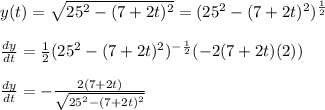
Physics, 15.04.2020 02:48 deaishaajennings123
A ladder 25 feet long is leaning against the wall of a building. Initially, the foot of the ladder is 7 feet from the wall. The foot of the ladder begins to slide at a rate of 2 ft/sec, causing the top of the ladder to slide down the wall. The location of the foot of the ladder at time t seconds is given by the parametric equations (7+ 2t,0).
I found the parametric equation for y(t) =√ 25^2 -(7+2t)^2
Calculate the average velocity of the top of the ladder on each of these time intervals (correct to three decimal places).

Answers: 3


Other questions on the subject: Physics

Physics, 21.06.2019 17:30, Xavier2712
Abatter hits the baseball a with an initial velocity of v0 = 110 ft/sec directly toward fielder b at an angle of 23° to the horizontal; the initial position of the ball is 2.2 ft above ground level. fielder b requires 0.44 sec to judge where the ball should be caught and begins moving to that position with constant speed. because of great experience, fielder b chooses his running speed so that he arrives at the “catch position” simultaneously with the baseball. the catch position is the field location at which the ball altitude is 8.4 ft. determine the velocity of the ball relative to the fielder at the instant the catch is made.
Answers: 1

Physics, 21.06.2019 21:30, genyjoannerubiera
Ahydroelectric plant takes energy from water and turns it into electrical energy. what are the transformations of energy in the water molecules that are used in the process of generating electricity this way?
Answers: 3

Physics, 21.06.2019 22:50, ijohnh14
If the temperature were raised very high, classically what would we expect the heat capacity per object to be for this one-dimensional system? give a numerical value. chigh t = __ j/k/object (one reason for the discrepancy is that the high-temperature limit assumes that the number of oscillators is large (n > > 1), which is not the case in this tiny system.)
Answers: 2

Physics, 22.06.2019 02:00, llamasking
Chapter 23, problem 075 the figure shows a geiger counter, a device used to detect ionizing radiation (radiation that causes ionization of atoms). the counter consists of a thin, positively charged central wire surrounded by a concentric, circular, conducting cylindrical shell with an equal negative charge. thus, a strong radial electric field is set up inside the shell. the shell contains a low-pressure inert gas. a particle of radiation entering the device through the shell wall ionizes a few of the gas atoms. the resulting free electrons (e) are drawn to the positive wire. however, the electric field is so intense that, between collisions with gas atoms, the free electrons gain energy sufficient to ionize these atoms also. more free electrons are thereby created, and the process is repeated until the electrons reach the wire. the resulting "avalanche" of electrons is collected by the wire, generating a signal that is used to record the passage of the original particle of radiation. suppose the radius of the central wire is 24 âµm, the inner radius of the shell 2.3 cm, and the length of the shell 14 cm. if the electric field at the shell's inner wall is 2.8 ă— 104 n/c, what is the total positive charge on the central wire?
Answers: 1
You know the right answer?
A ladder 25 feet long is leaning against the wall of a building. Initially, the foot of the ladder i...
Questions in other subjects:



Mathematics, 18.03.2021 18:40

Chemistry, 18.03.2021 18:40

Mathematics, 18.03.2021 18:40


Mathematics, 18.03.2021 18:40


Biology, 18.03.2021 18:40

Mathematics, 18.03.2021 18:40





![V_{B} = -2*\frac{\frac{Xo + 2t}{L} }{\sqrt{1-(\frac{Xo + 2t}{L}) ^{2} } } \n [m/s]](/tpl/images/0600/8819/fa876.png)

 ---(1)
---(1)

![V_{B} = L*cos\alpha *(-\frac{1}{sin\alpha }) *\frac{2}{L} = -2*Ctg\alpha [m/s]](/tpl/images/0600/8819/b9a8e.png)
![V_{B} = -2*\frac{cos\alpha }{\sqrt{1-cos\alpha ^{2} } } [m/s]](/tpl/images/0600/8819/0ec95.png)


